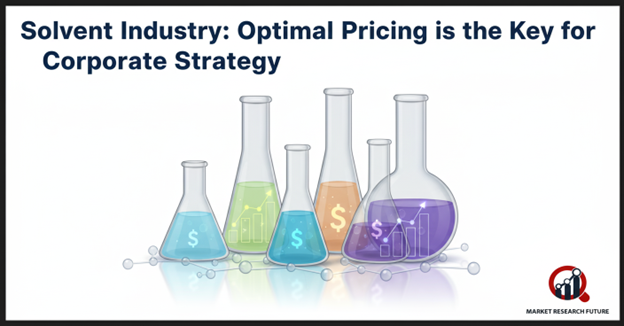Solvent Industry: Optimal Pricing is the key for Corporate Strategy

Solvent Market Overview
The global solvents industry plays a pivotal role in modern industrial chemistry, enabling the formulation, processing, and purification of a wide range of products—from paints and coatings to pharmaceuticals and personal care goods. As industries advance toward higher efficiency, cleaner formulations, and sustainable operations, solvent manufacturers are focusing on optimal pricing strategies and innovation to maintain competitiveness.
In recent years, rising raw material costs, environmental regulations, and demand for green chemistry have reshaped the global solvent market. The focus has shifted toward bio-based, low-VOC (volatile organic compound), and high-performance solvents that balance functionality, safety, and environmental compliance. For corporations, strategic pricing and value optimization have become essential to navigating this evolving marketplace.
What Are Solvents?
Solvents are liquids capable of dissolving, suspending, or extracting other materials without chemically changing either the solvent or the solute. Common examples include water, ethanol, acetone, toluene, and petroleum distillates such as gasoline or kerosene. Solvents play a critical role in facilitating chemical reactions, formulation of mixtures, and cleaning or extraction processes.
Solvents can be broadly categorized into:
- Oxygenated Solvents – alcohols, ketones, esters, and glycols used in paints, coatings, and inks.
- Hydrocarbon Solvents – aliphatic and aromatic hydrocarbons derived from petroleum, primarily used in adhesives and cleaning agents.
- Chlorinated Solvents – methylene chloride, trichloroethylene, and perchloroethylene, valued for metal degreasing and precision cleaning.
- Bio-based Solvents – derived from renewable feedstocks such as corn, sugarcane, and soy, these are gaining traction as sustainable alternatives.
The solubility, miscibility, and volatility of solvents define their use cases across diverse industries—ranging from coatings and pharmaceuticals to electronics, agrochemicals, and cleaning formulations.
Shifting Industry Dynamics
The solvents industry has undergone significant transformation over the past decade. Once dominated by petrochemical-based production, the market is now evolving under environmental, economic, and technological pressures. Key shifts include:
- Transition toward eco-friendly and bio-based solvents to reduce emissions and meet sustainability goals.
- Rising demand for high-purity solvents in pharmaceuticals and electronics.
- Adoption of digital monitoring and data-driven optimization in production and pricing strategies.
- Focus on supply chain transparency and circular economy models.
For corporate leaders, balancing cost efficiency with compliance and innovation is crucial. Strategic pricing, coupled with raw material optimization, determines profitability in this highly competitive market.
Key Market Growth Drivers
- Expanding End-Use Industries
The growing demand for paints, coatings, adhesives, and personal care products directly drives solvent consumption. The construction, automotive, and pharmaceutical sectors remain the largest consumers globally.
- Sustainability and Regulatory Compliance
Stringent environmental regulations, particularly in Europe and North America, are encouraging the adoption of low-VOC and bio-based solvents, reshaping market dynamics and encouraging R&D investments.
- Rising Demand for Specialty Solvents
Electronics manufacturing and pharmaceutical applications require high-purity solvents. The rise of semiconductors, EV batteries, and drug formulation has expanded the specialty solvents market.
- Emergence of Green Chemistry
Technological advances in green chemistry are enabling the production of high-performance bio-solvents with improved biodegradability and reduced toxicity, aligning with corporate sustainability goals.
- Corporate Pricing Strategies
As raw material prices fluctuate, strategic pricing based on value differentiation, efficiency, and sustainability has become essential for solvent manufacturers to sustain margins and market share.
Challenges
Despite strong demand, the solvent market faces several structural and operational challenges:
- Volatile Crude Oil Prices: Affect raw material costs and profit margins.
- Stringent Environmental Norms: Limit the use of traditional chlorinated and hydrocarbon solvents.
- High Transition Costs: Shifting to bio-based production requires significant capital and R&D investment.
- Health & Safety Concerns: Prolonged exposure risks and disposal challenges drive the need for safer alternatives.
Overcoming these challenges requires innovation in formulation chemistry, waste management, and production efficiency, along with policy support for green manufacturing.
Regional Insights
- North America: Dominates the global solvents market, driven by a mature industrial base, strong regulatory frameworks, and increasing adoption of eco-friendly formulations in the U.S. and Canada.
- Europe: Home to some of the world’s strictest environmental policies, Europe is a leader in bio-based solvent innovation and VOC reduction initiatives. Germany, France, and the U.K. are key markets.
- Asia-Pacific: The fastest-growing region due to rapid industrialization, infrastructure development, and expanding manufacturing sectors in China, India, Japan, and South Korea.
- Latin America: Emerging demand in Brazil and Mexico is supported by growth in automotive and coatings sectors.
- Middle East & Africa: While industrial activity is limited, increasing construction and chemical manufacturing are creating new market opportunities.
Future Outlook
The global solvent industry is entering a new era defined by sustainability, innovation, and strategic pricing. Companies are investing in bio-based alternatives, AI-driven demand forecasting, and integrated supply chain management to remain competitive.
Future success will depend on:
- Expanding renewable feedstock usage.
- Enhancing recyclability and circular solvent recovery.
- Leveraging advanced analytics for dynamic pricing models.
- Strengthening compliance with global sustainability mandates.
By aligning innovation with optimal pricing and environmental responsibility, solvent manufacturers can ensure long-term growth in an increasingly regulated and value-conscious marketplace.
Conclusion
The solvents industry remains the backbone of numerous industrial applications, but its future hinges on sustainable innovation and intelligent pricing strategies. As companies transition toward greener chemistry, optimizing cost structures while ensuring performance will be the key differentiator.
With a focus on eco-friendly products, digital transformation, and corporate agility, the global solvent market is set for steady expansion—reflecting the evolving balance between industrial growth, environmental stewardship, and economic value creation.

Leave a Comment